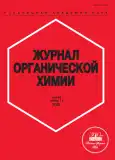Coupled electroreduction of CO2 and H+ in the presence of substituted salts of 2,2'-bipyridine
- Autores: Okina E.V.1, Klimaeva L.A.1, Chugunov D.B.1, Kostryukov S.G.1, Kozlov A.S.1, Tarasova O.V.1, Yudina A.D.1
-
Afiliações:
- National Research Ogarev Mordovia State University
- Edição: Volume 59, Nº 11 (2023)
- Páginas: 1482-1488
- Seção: Articles
- URL: https://journals.rcsi.science/0514-7492/article/view/247261
- DOI: https://doi.org/10.31857/S0514749223110095
- EDN: https://elibrary.ru/NCIWKA
- ID: 247261
Citar
Texto integral
Resumo
Palavras-chave
Sobre autores
E. Okina
National Research Ogarev Mordovia State University
L. Klimaeva
National Research Ogarev Mordovia State University
Email: l_klimaeva@mail.ru
D. Chugunov
National Research Ogarev Mordovia State University
S. Kostryukov
National Research Ogarev Mordovia State University
A. Kozlov
National Research Ogarev Mordovia State University
O. Tarasova
National Research Ogarev Mordovia State University
A. Yudina
National Research Ogarev Mordovia State University
Bibliografia
- Jenkinson D.S., Adams D.E., Wild A. Nature. 1991, 351. 304-306. doi: 10.1038/351304a0
- Weimer T., Schaber K., Specht M., Bansi A. Energy Convers. Manag. 1996, 370020, 1351-1356. doi: 10.1016/0196-8904(95)00345-2
- Liu J.-L., Wang X., Li X.-S., Likozar B., Zhu A.-M. J. Phys. D Appl. Phys. 2020, 53, 253001. doi: 10.1088/1361-6463/ab7c04
- Jessop P.G., Jo� F., Tai C.-C. Coord. Chem. Rev. 2004, 248, 2425-2442. doi: 10.1016/j.ccr.2004.05.019
- Glockler G. Phys. Chem. 1958, 62, 1049-1054. doi: 10.1021/j150567a006
- Tanaka K. BCSJ. 1998, 71, 17-29. doi: 10.1246/bcsj.71.17
- Ren S., Jouli� D., Salvatore D., Torbensen K., Wang M., Robert M., Berlinguette C.P. Science. 2019, 365, 367-369. doi: 10.1126/science.aax4608
- Jin S., Hao Z., Zhang K., Yan Z., Chen J. Angew. Chem. 2021, 133, 20795-20816. doi: 10.1002/ange.202101818
- Zhu D.D., Liu J.L., Qiao S.Z. Adv. Mater. 2016, 28, 3423-3452. doi: 10.1002/adma.201504766
- Alberico E., Nielsen M. Chem. Commun. 2015, 51, 6714-6725. doi: 10.1039/C4CC09471A
- Dong K. Razzaq R., Hu Y., Ding K. Top Curr. Chem. 2017, 375, 23. doi: 10.1007/s41061-017-0107-x
- Qiao J., Liu Y., Hong F., Zhang J. Chem. Soc. Rev. 2014, 43, 631-675. doi: 10.1039/C3CS60323G
- Zheng Y., Vasileff A., Zhou X., Jiao Y., Jaroniec M., Qiao S.-Z. J. Am. Chem. Soc. 2019, 141, 7646-7659. doi: 10.1021/jacs.9b02124
- Boutin E., Robert M. Trends Chem. 2021, 3, 359-372. doi: 10.1016/j.trechm.2021.02.003
- Lim R. J., Xie M., Sk M.A., Lee J.-M., Fisher A., Wang X., Lim K.H. Catal. Today. 2014, 233, 169-180. doi: 10.1016/j.cattod.2013.11.037
- Specht M., Staiss F., Bandi A., Weimer T. Int. J. Hydrog. Energy. 1998, 23, 387-396. doi: 10.1016/S0360-3199(97)00077-3
Arquivos suplementares









